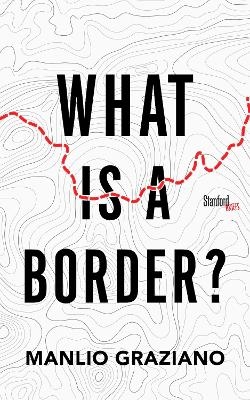
What Is a Border?
Stanford Briefs (Verlag)
978-1-5036-0539-8 (ISBN)
The fall of the Berlin Wall, symbol of the bipolar order that emerged after World War II, seemed to inaugurate an age of ever fewer borders. The liberalization and integration of markets, the creation of vast free-trade zones, the birth of a new political and monetary union in Europe—all seemed to point in that direction. Only thirty years later, the tendency appears to be quite the opposite. Talk of a wall with Mexico is only one sign among many that boundaries and borders are being revisited, expanding in number, and being reintroduced where they had virtually been abolished. Is this an out-of-step, deceptive last gasp of national sovereignty or the victory of the weight of history over the power of place? The fact that borders have made a comeback, warns Manlio Graziano, in his analysis of the dangerous fault lines that have opened in the contemporary world, does not mean that they will resolve any problems. His geopolitical history and analysis of the phenomenon draws our attention to the ground shifting under our feet in the present and allows us to speculate on what might happen in the future.
Manlio Graziano teaches geopolitics and geopolitics of religion at the Sorbonne, the Geneva Institute of Geopolitical Studies, and La Sapienza University in Rome. His books include In Rome We Trust (Stanford, 2017).
Contents and AbstractsIntroduction chapter abstractThis introduction deals with the question of whether and why the borders are topical despite the long wave of globalization and concludes that they are at the same time obsolete and topical—obsolete, because globalization has undermined them and topical because their weakening has led to a reshuffling of territories and identities. It also introduces the relative nature of borders, which are different in time and space, depending on different stages of development of countries.
1A Short History of Borders chapter abstractThis chapter provides a short history of borders, from prehistoric societies to the present. It challenges some conventional wisdom about the "natural" character of borders, as they were essentially and intrinsically linked to human nature. The chapter describes how territories were delimited at hunter-gatherer times, then when the first empires were born, then in the Middle Ages, and it shows how their modern role was born along with the principle of sovereignty. Part of the chapter is devoted to the birth of the idea of nation and its progressive implementation, to show how nation and borders grew up together. The chapter also deals with cosmopolitan, supranational, and postnational ideas and addresses the return of borders today, explicitly mentioning protectionism, Brexit, and the 2016 American elections.
2The Power of Place chapter abstractThis chapter deals with the different forms, roles, and ideas of borders in the contemporary world, starting with the uneven development of regions, resulting mass-migration movements, and reactions in the developed world. Then it introduces different forms of borders: the invisible borders within countries and societies; the religious borders, which are among the most stable borders, and therefore provide much relief to those who are constantly yearning for an identity; the electoral borders, that is, the increasing political use of borders for electoral purposes; and finally, the phantom borders, the eight states that are not recognized by the international community.
3Borders in Progress chapter abstractThis chapter examines the political role of borders in a series of specific cases. It starts with the different borders of Europe, why they are so numerous, and why they have changed so frequently. It then looks at the Middle East and Africa, where artificial borders and states are linked to political instability and war; the case of the incessantly moving borders of Russia, which is constantly in search of territorial protection; China, with a specific analysis of the buffer regions (i.e., nonethnically Chinese regions) as "natural borders," as well as the issue of its maritime borders and the disputed areas in the South China Sea; and the case of the United States, its particularly stable borders as opposed to the expansion of its frontier well beyond the limits of the Western Hemisphere and the unique openness of its borders to immigration over most of its history.
4Conclusion chapter abstractThe conclusion explains why a history of borders is so important in order to underline their relative character and identify the issue of the political comeback of borders and their likely future implication on international relations.
| Erscheinungsdatum | 15.02.2018 |
|---|---|
| Zusatzinfo | 1 table |
| Sprache | englisch |
| Maße | 127 x 203 mm |
| Themenwelt | Recht / Steuern ► EU / Internationales Recht |
| Sozialwissenschaften ► Politik / Verwaltung ► Europäische / Internationale Politik | |
| Sozialwissenschaften ► Soziologie | |
| ISBN-10 | 1-5036-0539-6 / 1503605396 |
| ISBN-13 | 978-1-5036-0539-8 / 9781503605398 |
| Zustand | Neuware |
| Haben Sie eine Frage zum Produkt? |
aus dem Bereich


